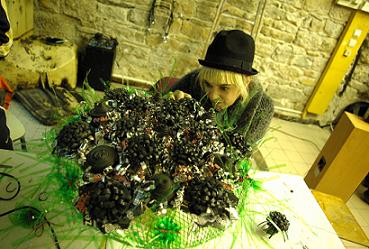EXPERIMENTAL PRACTICES - MARCH 2008
Analysing and thinking about experimental practices amounts to asking where the experiments take place and in what conditions. The ARTfactories/Autre(s)pARTs association groups together different experiments conducted in this sense which have some points in common, such as putting into perspective the relationships that exist between artists, works of art and individuals.
â–º BRIEF SUMMARY
The precedence of the process over the finished object
If there is a common point shared between all the experimental practices referred to during this workshop, it is the fact that research or experimental work is considered as an end in itself, with no obligation to produce a result. Whether they are organised in venues or through festival-type events, all these experiments give preference to multidisciplinary and collective work. They all question the status of the artistic work, the means used for producing it, and the ways in which is it received or perceived. Within this perspective, the process (of inception/conception, creation or production) is as important as the object for which the process may sometimes substitute itself, so that it is appropriate to speak of a sensible experience rather than an aesthetic experience. For that which is produced cannot be judged according to pre-existing aesthetic categories, and the participants in such a system are often themselves actively involved in an act (that of living this experience) and in a work (the thing that is produced).
The idea of system includes these two aspects and reflects the fundamental shift that takes place within the classic scheme of creator-work-spectator.
Therefore the artist may possibly not be in total control of their work, which itself may not be a finished object. As regards the public or audience, it may possibly not be assigned to the sole function or role of seeing/listening/reading/feeling/sensing the work.
Contrary to scientific experimentation, which analyses an object by examining it from a distance, the sensible experience in question here places the subject inside the very system itself to modify the perception that it has of itself and of its environment.
In the arts industry or in an arts institution, all the conditions are not right to allow this fundamental shift. The industry distinguishes practice from cultural consumption, while the institution imposes a very precise place for each thing and for each person. On the contrary, the experiments included within the Af/Ap association become merged with the place where they happen, and they pay very special attention to the “public†or “audience†(who should rather be called the “receivers†or even the local people...). Enabling these experiments to take place, and therefore allowing them to have a place, is a major challenge for the participants present at this workshop.
Specific places and specificities of place
Where is this possible? Theoretically, anywhere, as long as it is decided to do so. In reality,
preferably in ordinary places, which are usually disused, whose function and use are wavering
within a society. They are disused industrial premises, ruined farm premises, abandoned sheds and
warehouses, blocks of flats that are planned to be demolished, and so on. Questioning the aesthetic
experience implies doing so in a place that is also called into question: it is the ideal terrain for
playing with the real and the imaginary that are the raw material of the artistic experience.
Therefore it is not so much the “territories†(“territoires†[1] in French) and geographical areas
themselves that are new but the relations that one has with those that exist already. Rather than
creating elsewhere, in a different place, it is a matter of creating in a different way. Therefore the
notion of “territory†is not strictly geographical, but is similar to a space (which is virtual,
relational, etc.) where one will create by breaking with the instituted customary practices. Having
said so, customary practices durably mark certain cultural/arts amenities where it appears to be
difficult to work otherwise. In this case, to relaunch the history of cultural action, it is important to
work elsewhere. Nevertheless, this aim shared by all the various players concerned (artists, project
initiators, etc.) questions the desire of the spectators (or the “receivers†, local people, etc.) who are perhaps not ready to take part in this type of experiment...
This is a matter that obliges all these new practitioners to avoid remaining fixed in their actions or in their external relations, and to ensure that they are not confined or restricted to a precarious situation, with no recognition and caught in a perpetual state of emergence, just because they claim the right to conduct research and experimental work without being obliged to achieve a concrete result.
Sébastien Gazeau
Text written on the basis of the summary by Pierre Gonzales and Jules Desgoutte (Friche RVI, Collectif ABI/ABO, Lyon) in Sainte-Foy-Lès-Lyon on 19/03/08 during the discussion workshop on “Les pratiques expérimentales†[Experimental Practices]
Pierre Gonzales et Jules Desgoutte (members of Abi Abo, Friche RVI, Lyon)
Preparation and moderation of the Discussion Workshops
Quentin Dulieu (Af/Ap)
Coordination of the Discussion Workshops
[1] In this context in French, the word “territoire†goes beyond the normal limited meaning of “territory†.
It refers simultaneously to a neighbourhood, a geographical space or area, and the economic and social contexts within which the artist works, as well as cultural representations, and the positions of the various social players involved.




